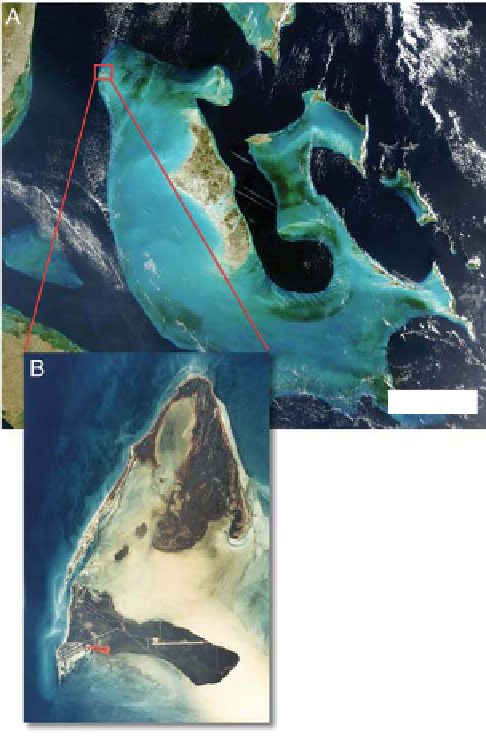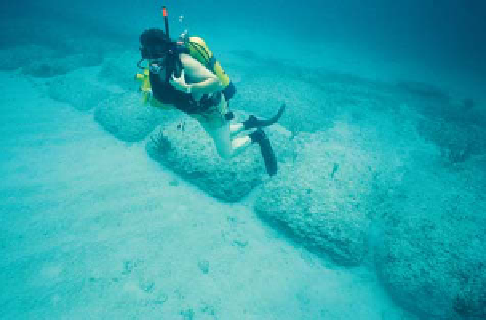Geology Reference
In-Depth Information
Gifford conducted the fi rst serious geological study
in the 1970s. Relying on keen observation, hand
specimens and some core samples, Gifford & Ball
(1980) determined that the stones were naturally
emplaced. In a study of supposedly anthropogenic
objects from the vicinity Harrison (1971), also
concluded the stones and their alignment were
natural. Adventurer and topic writer Peter
Thompkins later initiated and fi nanced a study
during which the stones were extensively sam-
pled with a newly developed coring device.
A summary of the expedition is provided by
Shinn (2004). The cores proved that the stones
are composed of
in situ
natural beachrock that
has been submerged by a combination of rising
Holocene sea level and erosion of underlying sand
(Shinn, 1978). Coring and examination showed
that they rest directly on weathered Pleistocene
limestone. The Pleistocene limestone is coated
by a reddish-brown calcrete, indicating subaerial
exposure preceding Holocene sedimentation and
beachrock formation.
Later, McKusick & Shinn (1980) presented bulk
14C age data from the cores. The dates ranging
from 3510 to 2745 years
BP
indicate the stones
are much too young to be part of the mythological
city/state of Atlantis, which was said to be a legend
7 ka when told to Plato 2 ka.
1
Randi (1981) also
concluded that the stones are natural, as did geolo-
gist Paul Hearty (Hearty & Denato, 1998). Richards
(1988), Cayce
et al
. (1988) and Denato (Hearty &
Denato, 1998) had already challenged the earlier
studies and at the time of writing, internet blog-
gers, including a sizeable group with a website and
a journal called
Atlantis Rising
have challenged all
science-based investigations. A psychologist (see
Little (2006), recently joined the ranks of alterna-
tive believers. He claims in his website that the
author (Shinn) is part of a government conspiracy
to prevent people from learning the true origin of
the stones.
Whereas the 1978 study by Shinn was based
on more than a dozen
in situ
core borings and
14
C
dates (McKusick & Shinn, 1980), human-origin the-
ories of formation were, and still are, based almost
entirely on the seemingly man-made pattern of
the stones. These hypotheses state that beaches,
and hence beachrock, cannot form such straight
lines. However, proponents of the hypotheses,
often point to the area of curved stones at their
southern end, called the 'inverted J', as proof of
their anthropogenic origin (Little, 2006). If ancient
man did construct the so-called Bimini Road or
(a)
(b)
100 km
2 km
Fig. 1.
(a) Satellite image of Great Bahama Bank and
Andros Island in the Bahamas. North is at top. Florida is
upper left corner. Inset (b) shows North and South Bimini.
The underwater Bimini Road parallels the northwest coast
of North Bimini. North Bimini and South Bimini are sepa-
rated by a navigation channel that leads to Bimini Harbour.
The harbour is partially protected by shallow water and a
series of mangrove-populated sand spits to the east. The
arrow indicates Port Royal.
Fig. 2.
Underwater view of the submerged 'Bimini Road'
beachrock stones.






